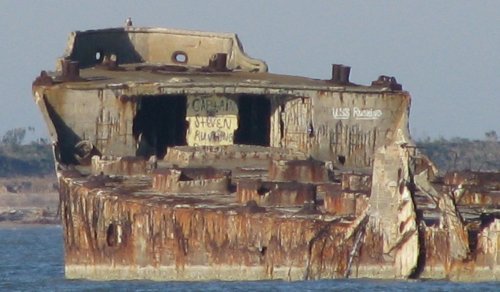The
SS Selma, a World War
I reinforced concrete tanker scuttled decades ago off the coast of
Galveston, Texas, and visible above the water line, is no longer just a
local curiosity.
Since
1992, besides
recognition with a Texas Historical Commission's Official Texas
Historical Marker, she has been designated as a State Archeological
Landmark by the Texas Antiquities Committee, as the Official Flagship
of the Texas "Army", and is listed on the National Register of Historic
Places.
In
addition , the SS
Selma rests in a significant site in Galveston Bay, the bay near the
"marine battleground" for part of the Civil War's Battle of Galveston
in 1863.
None
of these honors in the past
few years would have occurred had it not been for the tireless efforts
of a former city editor of the Galveston Daily News and retired copy
editor of the Houston Chronicle, A. Pat Daniels, of Houston, who
purchased the Selma in 1992. He has exhibited an uncommon love for the
old girl, so much that he throws a birthday party for her every year
with much fanfare, inviting many of the local Texas
luminaries and a few outsiders, myself included.
The War Effort
The
Selma, a 7500 ton
reinforced concrete tanker built in Mobile, Alabama, was launched on
June 28, 1919. She was one of several concrete ships conceived and
designed during World War 1. Construction was not completed until the
war ended.
She had a length 420 ft., a beam of 54 ft. and a draft with full cargo
of 26 ft.. Her loaded displacement was 13,000 tons. This vessel marked
the first use of shale aggregate expanded in rotary kilns for
lightweight structural concrete.
Steel
was in short supply
because of the war efforts and concrete was then proposed as a viable
alternative material for use in ship building. Feasibility studies by
marine engineers indicated that a reinforced concrete ship would be
practical if the concrete had a compressive strength of 5000 psi and
weighted no more than 110 lb\ft.. As a matter of fact, the Selma's
average compressive strength at 28 days was 5591 psi and the average
modulus of elasticity was 3,306,000 psi, well beyond all expectations.
The
hull of reinforced
expanded shale lightweight concrete was 5" thick at the bottom,
tapering to 4" on the sides. It required 2600 yds. of concrete
reinforced with 1500 tons of smooth reinforcing bars. Expanded shale
aggregaate was supplied in two graduations, fine and coarse.
Diatomaceous earth was also used in the concrete.
To
obtain proper placement
of concrete in the thin hull and throughout the heavy mats of
reinforcing steel the concrete mixture was quite fluid. Internal
vibration was also used to improve consolidation.
Engineers
in charge of the
project found it difficult to control the fluid and produce a uniform
batches. One of the engineers, Herbert A. Davis, developed an apparatus
for controlling consistency. He used a 6 x 12 in. (150 x 300 mm)
cylinder mold and an arrangement of fixed vertical tracks with which to
lift the mold. The cylinder was filled with concrete and then lifted.
This removed the cylinder from the concrete, allowing it to sag. The
distance of the sag was measured and reported as the "consistency drop"
in inches. This was the first successful effort to control the
consistency of concrete in the field by comparing one batch with the
next. This testing and others of a similar nature eventually led to the
modern slump cone test. (ASTM C 143)
Postwar
life of the Selma
The
Selma served several
ports in the Gulf of Mexico quite successfully. Unfortunately she ran
aground on the South jetty at Tampico, Mexico on May 11, 1920, creating
a sizeable crack about 60 ft. long in her hull. She was towed into
Galveston for repairs. Although the damage was repairable, the dry-dock
crew lacked the knowledge and had no experience repairing a
hull of
such material. With no guarantee of proper restoration, the U.S.
Government's Emergency Fleet Corporation decided not to gamble.
A
channel 1,500 ft. long and 25 ft.
deep was dug to a point just off Galveston near Pelican Island's
eastern shoreline. After being stripped of all valuable equipment, on
March 9, 1922 she was towed out to her final berth, and laid to rest.
This left the hull partly submerged, although awash when seas were
rough.
The
Selma has over the years been
object of many failed plans to convert her for use as a fishing pier,
pleasure resort and oyster farm. Long a source of curiosity and local
legend, she remains important to concrete and academic experts as an
object of study of her construction and durability following decades of
exposure to marine conditions.
The
Selma is still quite visible
today from the historic marker on Pelican Island and has become an
interesting artifact to be viewed by the locals and visitor tourists
alike. Although she will never sail again, she has been proudly
resurrected by Daniels and other proud Texans who believe she lives on
in spirit.


